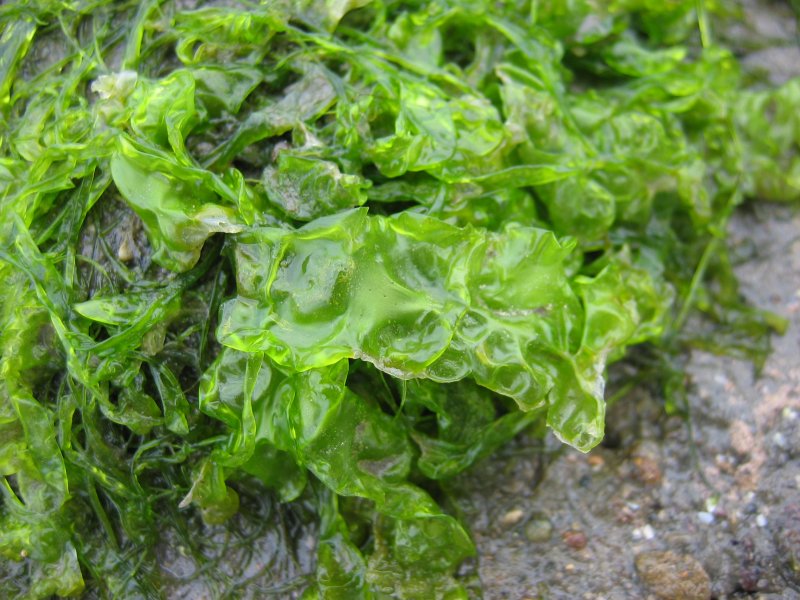- Ulva lactuca
Taxobox
color = lightgreen
name = "Ulva lactuca"

domain = Eukaryota
regnum =Protista
phylum =Chlorophyta
classis =Ulvophyceae
ordo =Ulvales
familia =Ulvaceae
genus = "Ulva"
species = "U. lactuca"
binomial = "Ulva lactuca"
binomial_authority = Linnaeus,1753 "
Ulva lactuca " Linnaeus, agreen alga in the DivisionChlorophyta , is thetype species of the genus "Ulva", also known by the common namesea lettuce .Description
"Ulva lactuca" is a thin flat green alga growing from a discoid
holdfast . The margin is somewhat ruffled and often torn. It may reach 18 cm or more in length, though generally much less, and up to 30 cm across. [cite web
url = http://www3.gettysburg.edu/~rcavalie/bda_i/078.html
work =Gettysburg College
title= Ulva lactuca
accessdate=2007-12-28] The membrane is two cells thick, soft and translucent. [cite web
url = http://omp.gso.uri.edu/doee/biota/algae/chloro/ulvaxf.htm
work =University of Rhode Island
title= Ulva lactuca
accessdate=2007-12-28] and grows attached, without a stipe, to rock by a small disc-shapedholdfast .Burrows, E.M. (1991) "Seaweeds of the British Isles. Volume 2 Chlorophyta." Natural History Museum, London. ISBN 0 565 00981 8] Green to dark green in color this species in the Chlorophyta is formed of two layers of cells irregularly arranged, as seen in cross section. Thechloroplast is cup-shaped with 1 to 3pyrenoid s. There are other species of "Ulva" which are similar and not always easy to differentiate.Distribution
The distribution is worldwide:
Europe , North America - west and east coasts,Central America ,Caribbean Islands, South America,Africa , Indian Ocean Islands, South-west Asia,China , Pacific Islands,Australia [http://www.algaebase.org/search/species/detail/?species_id=39&sk=0&from=results] , and New Zealand. [http://www.algaebase.org/search/species/detail/?species_id=39&sk=0&from=results] [cite web
url = http://www2.auckland.ac.nz/info/schools/nzplants/food_algae_ulva.htm
work =University of Auckland
title= Sea lettuce
accessdate=2007-12-28]Ecology
"Ulva lactuca" is very common on rocks and on other algae in the
littoral andsublittoral on shores all around theBritish Isles .Hardy, F.G. and Guiry, M.D. (2006). "A Check-list and Atlas of the Seaweeds of Britain and Ireland. "British Phycological Society, London. ISBN 3 906166 35 X] It is particularly prolific in areas where nutrients are abundant. [cite web
url = http://www.seaweed.ie/algae/ulva.lasso
work = the Seaweed Site
author = Michael Guiry
title= Overview of "Ulva lactuca" ecology
accessdate=2007-12-28]Life history
The sporangial and gametangial thalli are morphologically alike. The
diploid adult plant produceshaploid spores bymeiosis , these settle and grow to form haploid male and female plants similar to the diploid plants. When these haploid plants releasegametes they unite to produce thezygote which germinates, and grows to produce the diploid plant.Abbott, I.A. and Hollenberg, G.J. (1976). "Marine Algae of California." Stanford University Press, California. ISBN 0 8047 0867 3] Mondragon, J. and Mondragon, J. (2003). "Seaweeds of the Pacific Coast." Sea Challengers, Monterey, California ISBN 0 930118 29 4] [ [http://www.mbari.org/staff/conn/botany/greens/anna/frontpages/thecycle.htm Life-history diagram for "Ulva lactuca"] ,MBARI , accessed13 June 2007 ]Uses
"U. lactuca" is locally used in
Scotland in soups and salads.Indergaad, M and Minsaas, J. 1991 in Guiry, M.D. and Blunden, G. 1991. "Seaweed Resources in Europe: Uses and Potential." John Wiley & Sons ISBN 0 471 92947 6] [cite web
url = http://www.mbari.org/staff/conn/botany/greens/anna/frontpages/recipes.htm
work = Monterey Bay Aquarium Research Institute
title= Ulva Recipes
accessdate=2007-12-28]References
Further reading
* Hayden, H.S., Blomster, J., Maggs, C.A., Silva, P.C., Stanhope, M.J. and Waaland, J.R. (2003) [http://www.biosciences.bham.ac.uk/labs/callowj/ent/Hayden_Blomster_Maggs.pdf Linnaeus was right all along: "Ulva" and "Enteromorpha" are not distinct genera] . "Eur. J. Phycol." 38, 277-294.
External links
* [http://www.algaebase.org/search/species/detail/?species_id=39&sk=0&from=results "Ulva lactuca"] ,
AlgaeBase entry
* [http://omp.gso.uri.edu/doee/biota/algae/chloro/ulva.htm "Ulva lactuca"] ,University of Rhode Island
Wikimedia Foundation. 2010.
